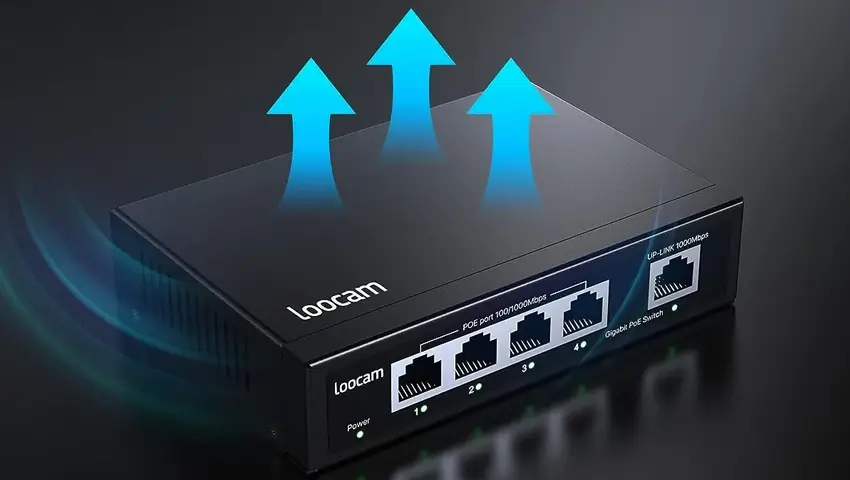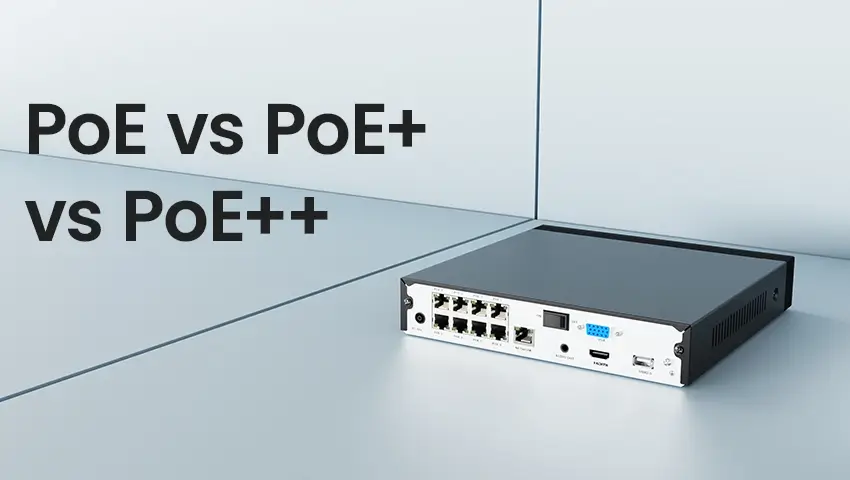We often receive questions from consumers about selecting the right PoE switch for their IP cameras. Typical queries include:
- How do I select a PoE switch for my IP cameras?
- Should I opt for a Gigabit PoE network switch for my IP security cameras?
- Can you recommend a PoE switch for managing more than 4 IP cameras?
To help you make an informed decision, here are some insights and tips on choosing a suitable, reliable, and high-quality PoE switch for your IP cameras:
Contents
What is a PoE Switch Used for IP Cameras?
A PoE switch simplifies the setup of power over Ethernet IP cameras by providing both power and data connections through a single Ethernet cable (Cat 5, Cat 5e, or Cat 6). Unlike a PoE injector, which typically powers and connects just one IP camera, a PoE switch features multiple ports to support several IP cameras simultaneously.
In essence, a PoE switch powers all your PoE devices, including IP cameras, computers, VoIP phones, and other network-enabled devices, through its multiple ports.
So, how do you choose the best PoE switch for your IP cameras? Here are some key considerations to guide your decision:
How to Choose a PoE Switch for IP Cameras
Selecting the right PoE switch for your IP security cameras involves careful consideration of several crucial factors. Here are the key aspects to keep in mind:
- Factor 1. PoE IP Camera Power Consumption
- Factor 2. PoE Switch Maximal Power Supply
- Factor 3. PoE Switch Power Supply Voltage
- Factor 4. PoE Switch Port Number
- Factor 5. Gigabit PoE Switch or Not
- Factor 6. Unmanaged or Managed PoE Switch
Factor 1. PoE IP Camera Power Consumption
A PoE switch must provide both network connectivity and power to IP cameras. Different cameras have varying power needs; for instance, PTZ IP cameras power consumption up to 20 watts, while others may use as little as 3 or 4 watts. Ensure the switch provides adequate power for all connected cameras via Cat 5 or Cat 6 cables.
There are two primary PoE standards to consider:
- PoE (IEEE802.3af): Provides up to 15.4W per port, delivering approximately 12.95W after losses.
- PoE+ (IEEE802.3at): Delivers up to 30W per port, with about 25.5W available in practice.
Double-check your camera’s power requirements in the user manual or spec sheet to ensure compatibility.
Factor 2. PoE Switch Maximal Power Supply
The total power supply capacity of the switch must meet or exceed the combined power requirements of all connected cameras. Insufficient power can lead to video loss and poor performance. It’s crucial to select a switch with a higher power capacity or limit the number of high-consumption PTZ cameras.
Factor 3. PoE Switch Power Supply Voltage
Many security cameras operate on either 12V or 24V. Using the incorrect voltage can damage the cameras. Opt for a PoE switch that can automatically adjust the voltage to match your cameras’ requirements, such as those compliant with IEEE802.3af.
Factor4. PoE Switch Port Number
Determine the number of cameras you need to connect and choose a switch with the corresponding number of ports. Options range from 8 ports up to 48 ports. Note the power supply capacity as it determines how many cameras each switch can support:
A 24-port switch with a 370W power supply can power 24 cameras under the IEEE802.3af standard but only 12 cameras under the IEEE802.3at standard.
Factor 5. Gigabit vs. Fast Ethernet PoE Switch
Choose a Gigabit switch to avoid becoming a data bottleneck, especially when powering multiple cameras and other network devices. Gigabit switches offer higher bandwidth compared to 10/100 Mbps switches. (Learn whether IP security cameras slow down your home network)
Factor 6. Unmanaged vs. Managed PoE Switch
- Unmanaged PoE Switch: Easy to use, plug-and-play, and cheaper. Ideal for most homeowners.
- Managed PoE Switch: Offers advanced features like network protocol configuration, VLANs, and IGMP Snooping, but at a higher cost. Suitable for more complex network setups.
By considering these factors, you can select a PoE switch that ensures reliable power and network connectivity for your PoE IP cameras, enhancing the overall security of your setup.
Conclusion
Opting for an NVR with a built-in PoE switch can save users from extensive research and technical hassles, allowing for a simple plug-and-play setup for their IP cameras.
However, selecting a reliable and suitable PoE switch is crucial for ensuring consistent power supply and network connectivity to your IP cameras. A good PoE switch enhances the performance and reliability of your surveillance system.

